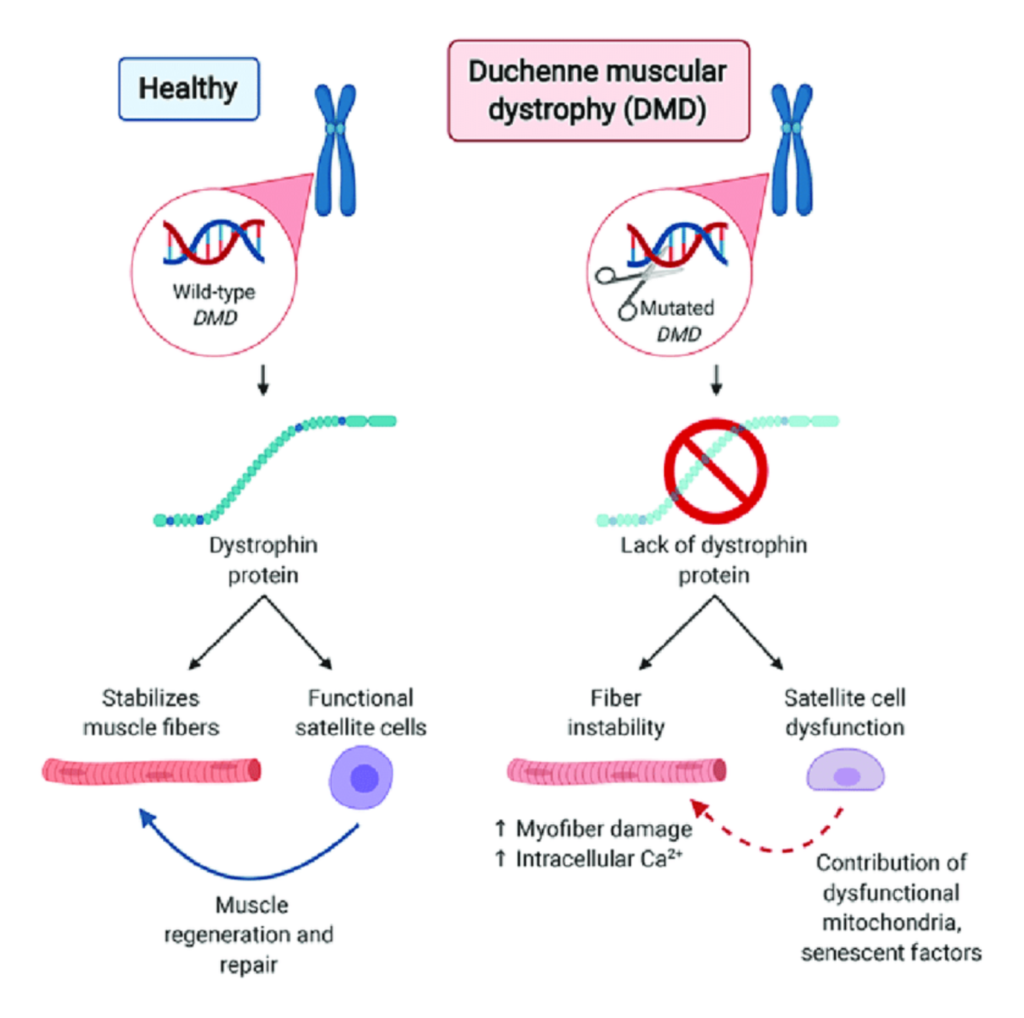STEM | October 24, 2023
UIUC Researchers Find New Revelations in the Causes of Muscle Weakness in Duchenne Muscular Dystrophy
Jenna Nabelsi

The key pathologic change of the Duchenne muscular dystrophy is the myonecrosis. Credit: Jose Luis Calvo Martin & Jose Enrique Garcia-Mauriño Muzquiz
This continuous decline in muscular strength and quality is ultimately responsible for the poor living conditions of DMD patients. Actions that most people can take without even thinking, are very difficult for DMD patients. Walking, talking, and swallowing are severely impaired, and muscles like the heart and diaphragm that keep people alive and breathing are affected. Muscles needed for daily life and basic bodily functions are severely weakened, leaving DMD patients with an extremely low quality of life. Most children are wheelchair-bound by 12, and facing death in their teens or early twenties.

Limb-Girdle Muscular Dystrophy. Credit: MedlinePlus
However, new research on the signaling pathway responsible for regulating muscle quality and quantity has revealed a new understanding of the causes of the decline in muscle quality. The University of Illinois at Urbana Champaign’s professors Jae-Sung You, Yongdeok Kim, Soohyun Lee, Rashid Bashir, and Jie Chen co-published revolutionary findings regarding the molecular pathway that causes muscle weakness in Duchenne muscular dystrophy in their publication: “RhoA/ROCK signaling activated by ARHGEF3 promotes muscle weakness via autophagy in dystrophic mdx mice.” This creates new potential for developing therapies to target muscle weakness, creating hope for increased health and longer life expectancy for DMD patients.
In the experiment, researchers used two samples to examine how cells respond to variable manipulation: 3-D engineered, DMD-affected muscles, and DMD mice. The manipulated variable (independent variable) was the amount of the signaling molecule (ARHGEF3), and the measured variable (dependent variable) was the muscular quality. The researchers controlled levels of the signaling molecule, observing the results using a precise test that measures rodent muscle properties (1300A Whole-Animal System) and a special microscope that canpick up pulses of energy caused by muscle strength and movement. As they were completing the experimental stage of this research, they were surprised to find an accessible way to possibly target the pathway to decrease the signaling molecule. They found that the process of the body cleansing its cells of toxins (autophagy) is directly related to the DMD-causing pathway. Researchers then tested how manipulating the process of autophagy impacts levels of the signaling molecule and the cellular pathway. After repeatedly experimenting with both signaling molecule levels and the process of autophagy, compelling results hint at possible treatments for DMD.
They found that the signaling pathway that causes DMD is a form of negative regulation.To put it simply, think of the signaling molecule as the speed of a car and the amount of muscle quality as the time of travel. The slower a car travels, the longer the amount of time it takes to reach a destination. Similarly, as the amount of the signaling molecule decreases, the muscle quality increases. So, negative regulation refers to the inverse, or opposite, relationship between the amount of signaling molecules and the amount of muscle quality. When they treated DMD-inflicted engineered muscle and mice, signaling molecule inhibitors were found to significantly improve muscle

DMD is a two-pronged disease. Credit: Natasha Chang
strength and alleviate the loss of muscle functionality and symptoms like twitching and spasming. Additionally, the researchers’ exploration of the pathway’s connection to autophagy revealed inhibition of autophagy increased specific muscular forces. With all of these findings, there is a real, possible way to target the pathway to aid in increasing muscle function and relieving symptoms for inflicted patients. This research is life-altering for DMD patients because it highlights the specific mechanism to target to create a gene therapy capable of treating DMD and by extension, possibly other forms of muscular dystrophy.

Gene therapy for Duchenne Muscular Dystrophy. Credit: Marisa Wexler, MS
While the potential for targeted gene therapy for restoring dystrophin levels still poses several difficulties due to limited knowledge of all DMD mutations, targeting autophagy can bypass this issue while still providing beneficial effects and relieving the disease’s severity. There are still many major barriers and hurdles for DMD treatments, but these advancements and findings are a profound stepping stone in the right direction towards alleviating muscular dysfunction and weakness for DMD patients, enabling them better quality of life. With these possible targeted therapies, patients with DMD can walk, talk, breathe, and function for significantly longer than before, and will have the chance to live a more normal, healthier life.
References
___________________________________________________________________________________________________________
- You, S., Kim, Y., Lee, S., Bashir, R., & Chen, J. (2023). RhoA/ROCK signaling activated by ARHGEF3 promotes muscle weakness via autophagy in dystrophic mdx mice. Journal of Cachexia, Sarcopenia and Muscle, 14(4), 1880-1893. https://doi.org/10.1002/jcsm.13278
- “1300A: 3-in-1 Whole Animal System for Mice.” Aurora Scientific, 15 Sept. 2023, aurorascientific.com/products/muscle-physiology/systems/1300a-whole-animal-system-mice/.
- “About Duchenne Muscular Dystrophy.” Duchenne.Com, www.duchenne.com/about-duchenne#:~:text=Dystrophin%20acts%20like%20a%20 shock,repair%20themselves%20 after%20an%20 injury. Accessed 17 Oct. 2023.
- Duchenne Muscular Dystrophy Fact Sheet, www.mda.org/sites/default/files/2019/03/Duchenne_Muscular_Dystrophy_Fact_Sheet.pdf. Accessed 18 Oct. 2023.
- “Limb-Girdle Muscular Dystrophy: Medlineplus Genetics.” MedlinePlus, U.S. National Library of Medicine, medlineplus.gov/genetics/condition/limb-girdle-muscular-dystrophy/. Accessed 19 Oct. 2023.
- professional, Cleveland Clinic medical. “Duchenne Muscular Dystrophy (DMD): Symptoms & Treatment.” Cleveland Clinic, my.clevelandclinic.org/health/diseases/23538-duchenne-muscular-dystrophy-dmd. Accessed 19 Oct. 2023.
- Duchenne Muscular Dystrophy Is a 2-Pronged Disease … – Researchgate, www.researchgate.net/figure/Duchenne-muscular-dystrophy-is-a-2-pronged-disease-Duchenne-muscular-dystrophy-DMD-is_fig2_351159052. Accessed 20 Oct. 2023.
- Marisa Wexler, MS. “Gene Therapy for Duchenne Muscular Dystrophy.” Muscular Dystrophy News, 7 Sept. 2023, musculardystrophynews.com/gene-therapy-for-duchenne-muscular-dystrophy/.
About the author
Jenna Nabelsi is a freshman at UIUC. She is studying Molecular and Cellular Biology on the premedical track, aspiring to become a surgeon. Some of her favorite hobbies include tennis, music, and reading and her favorite spot on campus is BrewLab.